The AMD Radeon RX 480 Preview: Polaris Makes Its Mainstream Mark
by Ryan Smith on June 29, 2016 9:00 AM ESTPower, Temperature, & Noise
Given AMD’s focus on power efficiency with Polaris – not to mention the overall benefits of the move to 14nm FinFET – there is a lot of interest in just how the RX 480 stacks up when it comes to power, temperature, and noise. So without further ado…

When it comes to idle power consumption I'm posting the results I've measured as-is, but I want to note that I have low confidence in these results for the AMD cards. Ever since the GPU testbed was updated from Windows 8.1 to Windows 10, AMD cards have idled 3-5W higher than they used to under Windows 8.1. I believe that this is an AMD driver bug – NVIDIA’s cards clearly have no problem – possibly related to the GPU tested being an Ivy Bridge-E system. In this case I don’t believe RX 480’s idle power consumption is any higher than GTX 960’s, but for the moment the testbed is unable to prove it.
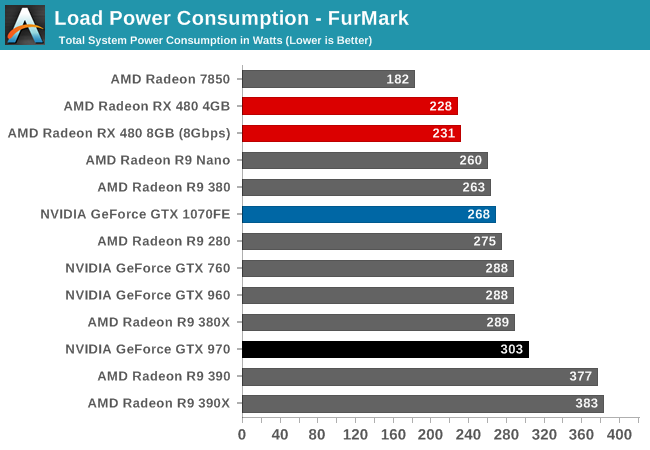
Traditionally we start with gaming load power before moving on to FurMark, but in this instance I want to flip that. As a power virus type workload, FurMark’s power requirements are greater than any game. But because it’s synthetic, it gives us a cleaner look at just GPU power consumption.
Among AMD’s cards, the RX 480 is second to only the Radeon HD 7850 in power consumption. Even then, as a GCN 1.0 card, the 7850 is one of the last AMD cards without fine-grained power states, so this isn’t a true apples-to-apples comparison. Instead a better point of reference is the GCN 1.2 based R9 Nano, which has a 175W TBP. Compared to the R9 Nano we find that the RX 480 draws about 30W less at the wall, which almost perfectly translates to the 25W difference in TBP. As a result we can see first-hand the progress AMD has made on containing power consumption with Polaris.
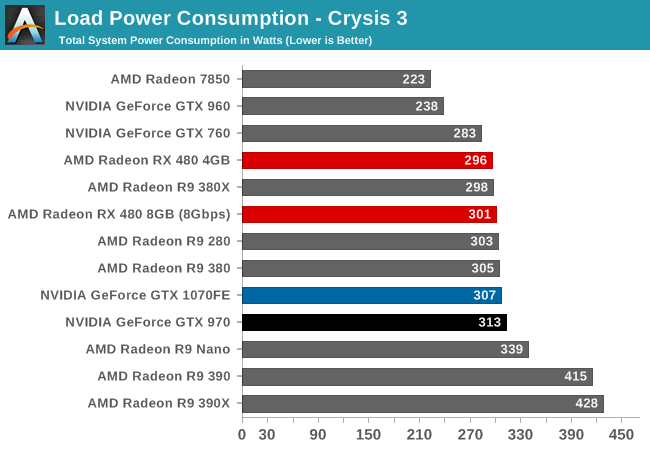
However things are a bit more mixed under Crysis 3. RX 480 is still near the top of our charts, and keeping in mind that higher performing cards draw more power on this test due to the additional CPU workload, the RX 480 compares very favorably to the rest of AMD’s lineup. System power consumption is very close to R9 280/380 for much improved performance, and against the performance-comparable R9 390, we’re looking at over 110W in savings. Hawaii was a solid chip from a performance standpoint, and Polaris 10 picks up where that left off by bringing down the power consumption to much lower levels.
The drawback for AMD here is that power consumption compared to NVIDIA still isn’t great. At the wall, RX 480 is only about 10W ahead of the performance-comparable GTX 970, a last-generation 28nm card. 1070FE further complicates matters, as its performance is well ahead of RX 480, and yet its power consumption at the wall is within several watts of AMD’s latest card. Given what we saw with FurMark I have little reason to believe that card-level power consumption is this close, but it looks like AMD is losing out elsewhere; possibly with driver-related CPU load.
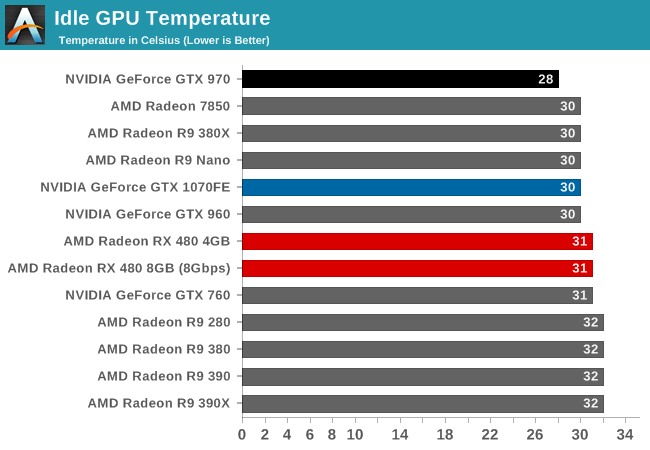
Moving on to idle GPU temperatures, there’s little to remark on. At 31C, the RX 480’s blower based design is consistent with the other cards in our lineup.
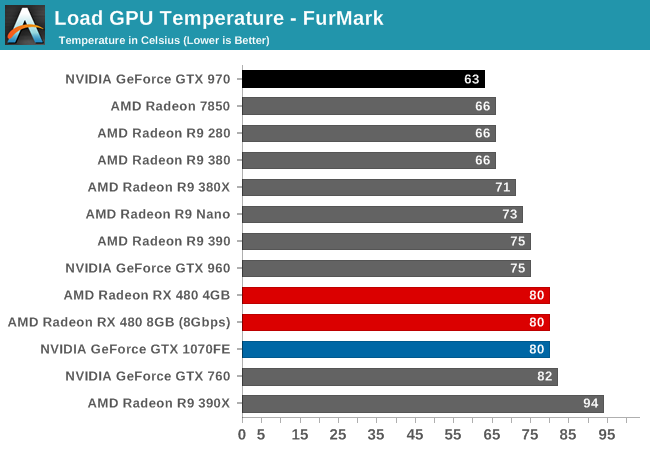
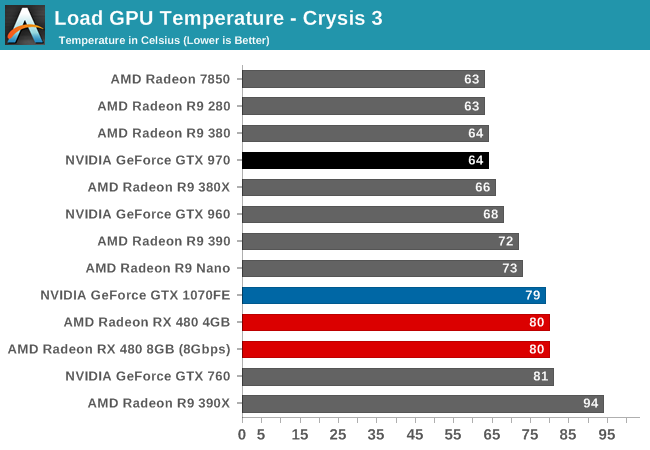
Meanwhile with load temperatures, we get to see the full impact of AMD’s new WattMan power management technology. The RX 480 has a temperature target of 80C, and it dutifully ramps up the fan to ensure it doesn’t exceed that temperature.

With idle noise levels RX 480 once again posts a good result. At 37.8dB, it’s in good company, only meaningfully trailing cards that idle silently due to their respective zero fan speed idle implementations.
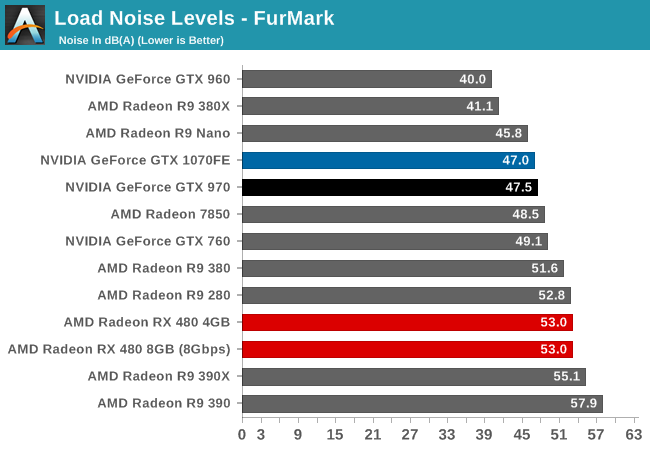
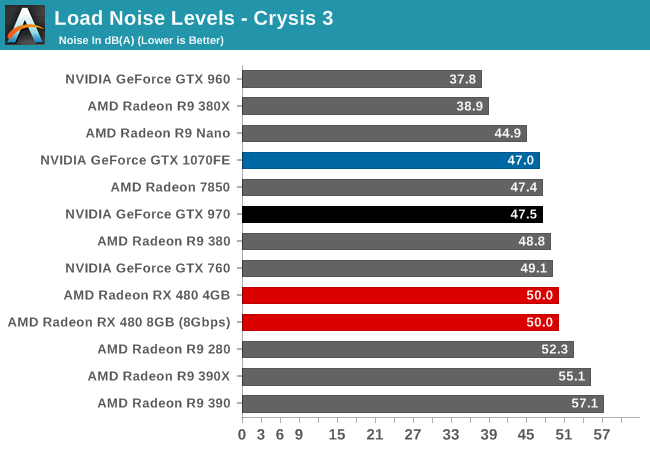
Finally, with load noise levels, RX 480 produces middling (but acceptable) results. Given that we have a mix of blowers and open air coolers here, the RX 480 performs similarly to other mainstream blower based cards. The $199 price tag means that AMD can’t implement any exotic cooling or noise reduction technologies, though strictly speaking it doesn’t need them.










449 Comments
View All Comments
TheinsanegamerN - Thursday, June 30, 2016 - link
So it cant to 60FPS constant at 1080p, but it CAN do 90FPS constant at 2160x1200? Did you fail math?Sushisamurai - Friday, July 1, 2016 - link
I think the point of yojimbo's post is that it should be able to hit 90fps @2160x1200 at medium to low settings. It can't hit 60FPS at ultra high settings at 1080pYojimbo - Friday, July 1, 2016 - link
Yes exactly. Ironically, math is my area of expertise.cocochanel - Thursday, June 30, 2016 - link
You must be smarter than the engineers at AMD. They said this card was designed for VR, they would not make such a claim if the card did not deliver. 3-4x higher performance ? Where do you live ?CiccioB - Friday, July 1, 2016 - link
In a world where marketing claims results to be false for most of the times.Wasn't Polaris 10 going to have 2.5x efficiency gain vs GCN? An AMD engineer told that as well. And has even put it on a slide.
I just saw 40% gain. While Pascal gained more than 60% over Maxwell. Which was still 40% better than GCN.
If an AMD engineer tells you that this card can fly, would you accelerate the fan at the level to try that claim? You know, an engineer has told you that it can! And it was an AMD engineer, nothing less!
FriendlyUser - Wednesday, June 29, 2016 - link
Perf/W would be much better if they had used GDDR5X, which they did not, for cost reasons. HBM is even more power efficient. Then you have the board itself, which probably is not as electrically sophisticated as the much more expensive nVidia 1080 board. Finally, you don't know which of the two process technologies is better for perf/W (two different foundries). In the end, I don't think the chip design is the main difference.Yojimbo - Thursday, June 30, 2016 - link
The RX 480's perf/W is really no better than the GTX 970, which uses GDDR 5 RAM like the RX 480 as well as a 28nm process compared with the 14nm process of the RX 480. I do think the architecture is the main difference. Polaris 10's architecture seems to be significantly less efficient than Maxwell's, after accounting for the advantage of the 14nm process of the RX 480. Pascal is even more efficient architecturally than Maxwell.Meteor2 - Wednesday, June 29, 2016 - link
The 1080/1070 take the performance/power crown. But the 480 comfortably takes the performance/price crown. What's interesting is that the 1080 isn't quite fast enough for AAA titles at 4K and the 1070 sits in no man's land, while the 480 runs AAA and 1080p and does VR. It's clear which option is the solid buy.Yojimbo - Thursday, June 30, 2016 - link
Yes the RX 480 will take the performance/price crown assuming supply can keep up with demand, but for how long? The GTX 1060 will be out in a month or two and be very competitive in price/performance.The 1080 is fast enough for AAA titles at 4K if one doesn't max out the settings. A similar thing can be said for the 1070. Also similar is RX 480's VR claim. It can only manage VR gaming when settings are not maxed out. Are you a console gamer or you just have selective memory? This paragraph should be redundant for a PC gamer.
Demibolt - Friday, July 1, 2016 - link
Not here to argue, just fact checking.GTX 970 can be purchased for ~$240 from several online retailers (less if you get a used one from ebay). Given the close performance figures between the 2 cards and the inevitable price-drop that will happen with the GTX 970, It is objectively too soon to say the price/performance benefit of one cards beats out the other.